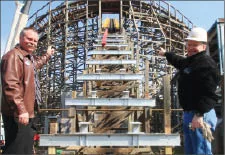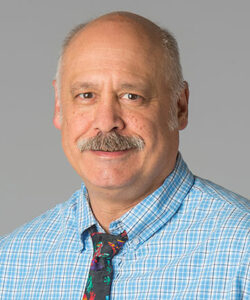Contractor to put rides on fast tracks
Hayden builder claims its design will revolutionize wooden roller coasters

Rocky Mountain Construction Group Inc., of Hayden, Idaho, a specialty contractor known for building thrill rides and water parks, is installing a new type of steel track and steel support structure of its own design that it believes will revolutionize wooden roller coasters.
The track system will allow roller coasters to operate at higher speeds, plunge over steeper drops, and bank more severely on turns than is possible with conventional tracks on all-wood base structures, says Fred Grubb, Rocky Mountain's president and co-owner along with his wife, Susan Dedmon.
Earlier this month, the company started installing the track system—the first of its kind—as part of a $10 million renovation of the 20-year-old Texas Giant wooden roller coaster at the Six Flags Over Texas theme park, near Arlington, Texas, Grubb says.
The proprietary track system involves steel tracks and steel cross beams that are fabricated at Rocky Mountain Construction's plant in Hayden and shipped to the theme park, where the company is installing them on the wooden structure, Grubb says. The track system is designed to reduce stress on the wooden structure, allowing more aggressive speeds and turns, he says.
The conventional track system on wooden roller coasters involves a pair of steel straps, or tracks, that lie on a nine-layer wood-laminate base rather than metal cross beams, Grubb says. As wooden coasters have gotten bigger and faster, wood-based track systems have been subjected to increasing amounts of stress, and some must be repaired every three to four years, making wooden coasters more expensive to maintain than steel-framed coasters, which cost more to build, he says.
On the Texas Giant, the steel track system will be much stronger, although, at 1 million pounds, it will weigh about the same as the original wood-based track system, Grubb says.
The ride on the steel track system will offer more thrills and a smoother ride without significantly altering the overall feel of a wooden coaster, Grubb says.
"Wooden roller coasters and steel roller coasters feel different," he says. "That's why they still make both kinds."
When the Texas Giant renovation is completed early next year, the coaster structure will be 153 feet tall—10 feet higher than before—and it will have the steepest drop of any wooden roller coaster in the world, boosting its top speed by 5 percent to 65 mph, all thanks to the new track design, Grubb asserts.
Grubb says he expects that the new track system will become the industry standard for wooden roller coasters, potentially making it the largest profit center for Rocky Mountain Construction.
"We'll be able to do more with the wooden-coaster ride," he says. "We will be able to put loops in wooden coasters. We haven't been able to do that before we developed this technology."
Grubb says it has taken three years to engineer the new track system.
"We started fabricating the new track three months ago," he says.
The company owns an 8,800-square-foot, office-and-shop building in the Warren K. Industrial Park, in Hayden, and recently leased a 10,000-square-foot building in the park to house its track fabrication plant.
Rocky Mountain Construction has a core of 20 permanent employees, and expects to add 10 more in its track division, Grubb says. It also hires workers on a temporary basis at its job sites.
Rocky Mountain has bids pending out to install its new system on other wooden coasters, including a proposed new coaster in China, he says.
"The interest is tremendous in the industry," Grubb says.
He says Rocky Mountain Construction has applied for a patent on the system.
"We've spent a lot of time and effort developing the program," he says. "We're the only one that has developed the technology to do it."
Grubb founded Rocky Mountain Construction in 2001 after erecting the Timber Terror and Tremors wooden roller coasters at Silverwood Theme Park, near Athol, Idaho. The company has built wooden- and steel-framed coasters across the country and in South Korea.
Grubb declines to disclose Rocky Mountain Construction's revenues, but says they have grown annually, despite the recession.
"We've been fortunate to be super busy," he says. "We're one of the leaders in track repair and reconditioning, and we've worked in New York, Arkansas, California, and Texas in the last year."
He says the company also has landed a big job for a new coaster in Brazil.
In addition to roller coasters, Rocky Mountain Construction has built water parks, miniature golf courses, gravity-powered cable rides called zip lines, a go-kart track, and large steel aircraft hangars and commercial shop buildings.
Related Articles


_c.webp?t=1763626051)
_web.webp?t=1764835652)

